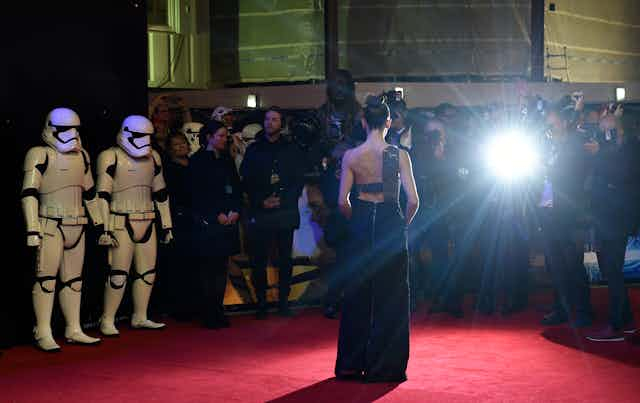In a galaxy far, far away, Rey, the heroine of the latest Star Wars movie, asserts her position as an independent woman. She’s not overly sexualised like so many leading women, nor is she a woman playing the role of a man. Instead, she is a standalone woman leading a fight. She does not need to be protected or saved by a man – the standard trope of a Hollywood blockbuster.
This is a movie that puts women front and centre and more than comfortably passes the Bechdel test – it is a positive step in the representation of women as leaders.
Rey stands shoulder to shoulder with general Leia (the only major female character in the original trilogy) and is backed up by female X-Wing pilots. Even the baddies have a tough woman leader – the blaster-toting Captain Phasma, played by Gwendoline Christie.
This is particularly noteworthy in a genre so often dominated by the manliest of men. Leia is a perfect example of how times have changed. The enduring image of her part in the first trilogy is of her as a slave in a metal bikini. Now she is a general sporting army fatigues.
The women characters are no longer just there to add sexiness. They are the story. It’s as though the force has awoken.
Many would have you believe that this is simply a reflection of our own galaxy – a sign that women today can expect to lead and be followed. But I am less confident.
The insidious nature of gender stereotypes, how they are embedded in culture, and the societal propensity for roles based on gender means progress towards equality is glacial at best.
Draw me a leader
There is no doubt that the glass ceiling is still firmly in place. Positions at the highest echelons of society are still dominated by men, women face barriers in their career due solely to their gender, and the view of leadership as masculine continues to dominate.
World Economic Forum data suggests there will not be equality of pay for another 118 years. And even if that weren’t the case, pay parity is not equality.
I often ask students to draw a leader. Time and time again, the majority of pictures I get back will be of men in suits – even if they were drawn by women. Sometimes I will ask them to name great leaders, the list is dominated by men.

I do this to explore how people perceive leaders and their qualities. We all hold ideas of leaders in our heads, these are shaped by experiences we have, the people we come into contact with and societies we grow up in. They are useful heuristics that enable us easily to navigate the complex social environments we operate in on a daily basis.
However, these models are open to bias and, as shown by my drawing studies, the link between leader and man is still firmly in place. These stereotypes are deeply ingrained, socially reinforced and not easily understood.
Awakening our own force
Role models have, and will continue to influence what we imagine when we think of a leader. The rise in powerful female characters such as Rey and Katniss from the successful Hunger Games series, alongside business leaders such as Marissa Meyer and the first British astronaut Helen Sharman are positive signs of change. These women can be powerful role models for the future generation of leaders across fields.
Yet at the same time, the British government plans to remove the feminist movement from the A-level politics curriculum, returning women to the footnotes of history. Then there are cases like that of Australian Essena O'Neill, who faced torrents of abuse for speaking out about the pressure she felt as an Instagram star because of gender stereotypes.
Situations such as these will do nothing to narrow gender divisions. Quite the opposite is needed, more women role models for the young women and men at school today.
We should celebrate the positives steps that are being taken towards greater equality between the sexes but the small wins should not lull us into thinking the glass ceiling no longer exists.
The implicit models of leadership I see being communicated in the classroom suggests there is a long way to go yet. My daughter and my granddaughter and even my great granddaughter will continue to face unfair barriers that prevent them from achieving their goals purely due to their gender. Perhaps I’ll start screening Star Wars at the beginning of every semester – at least until planet Earth catches up.

